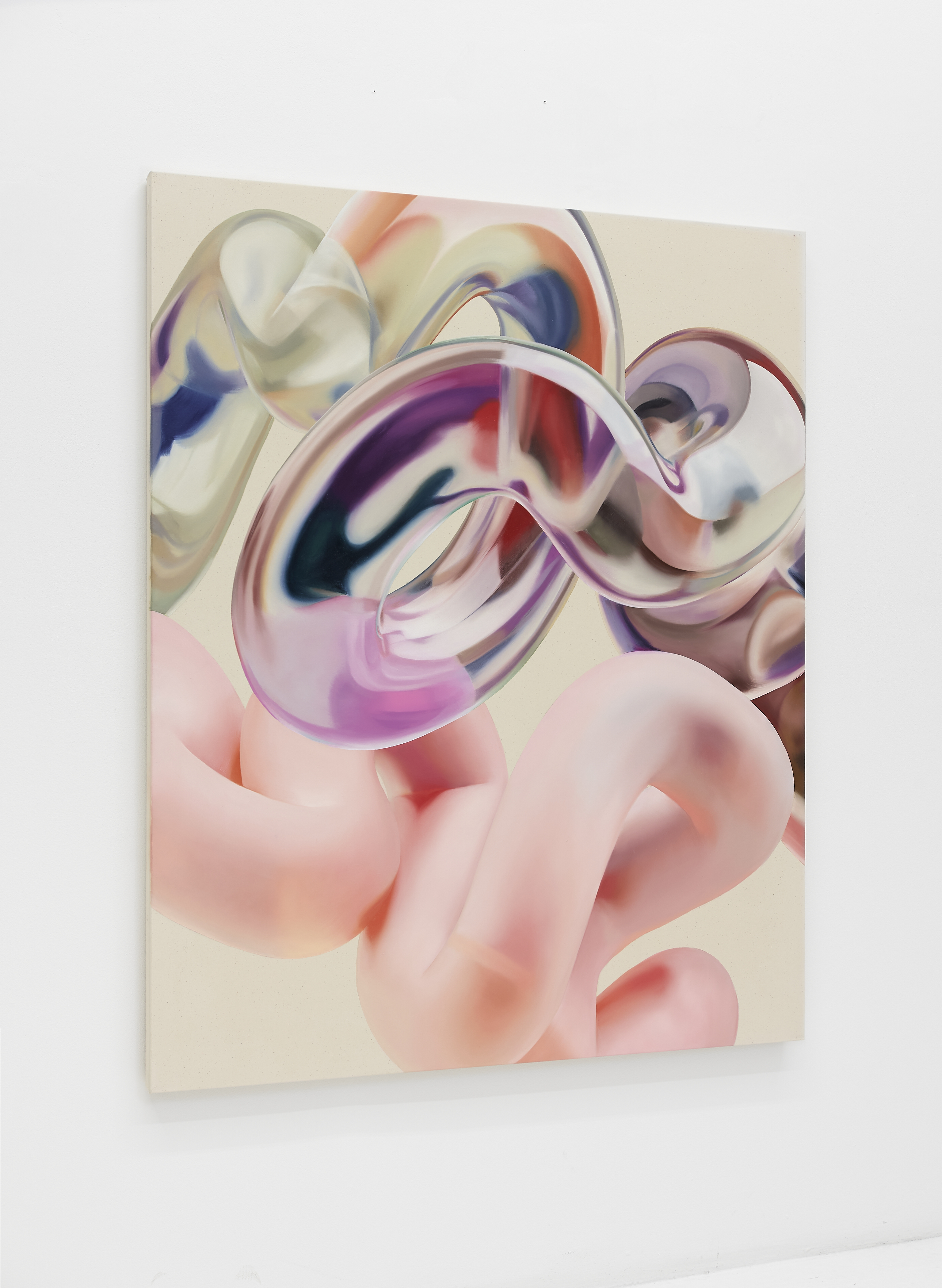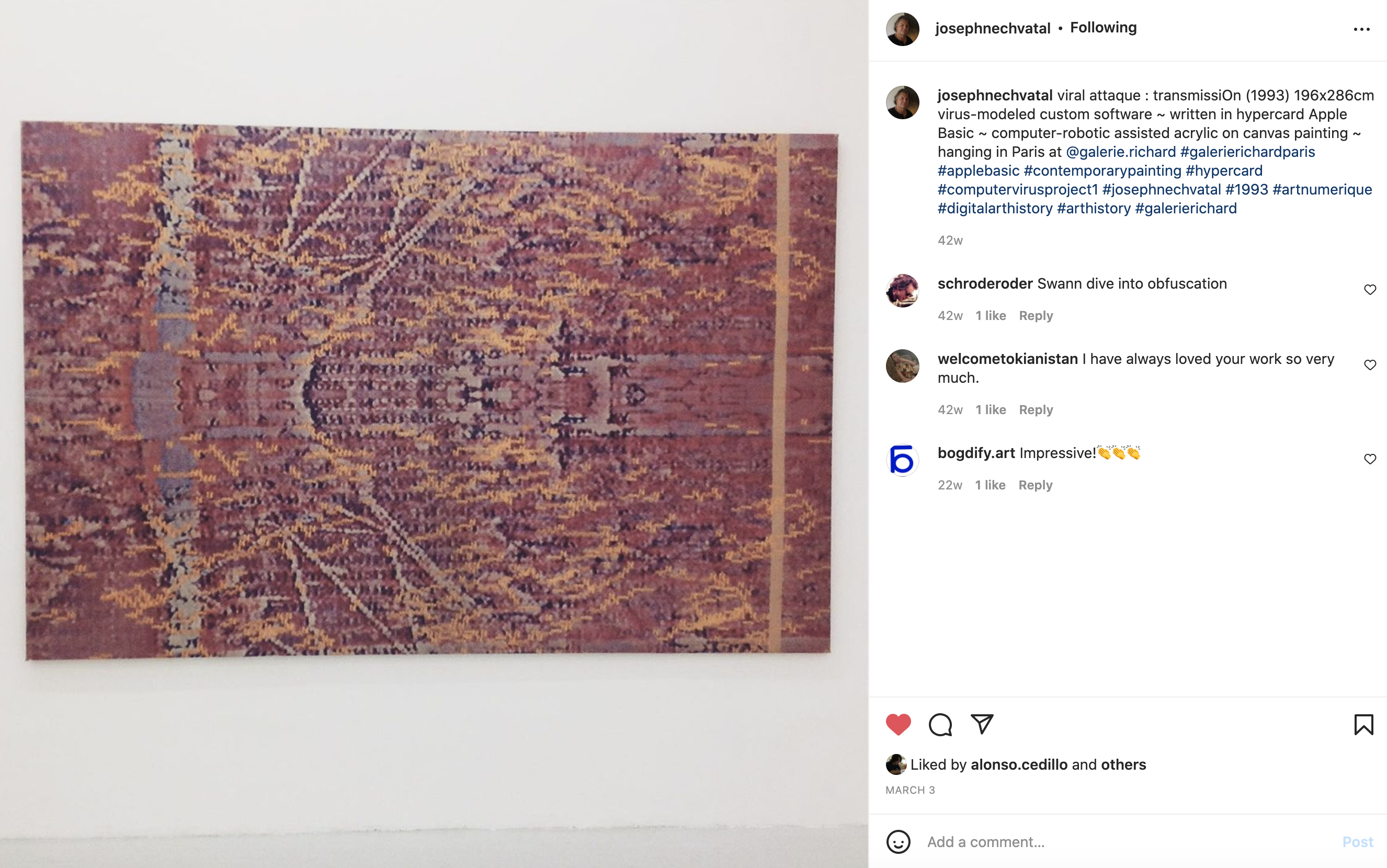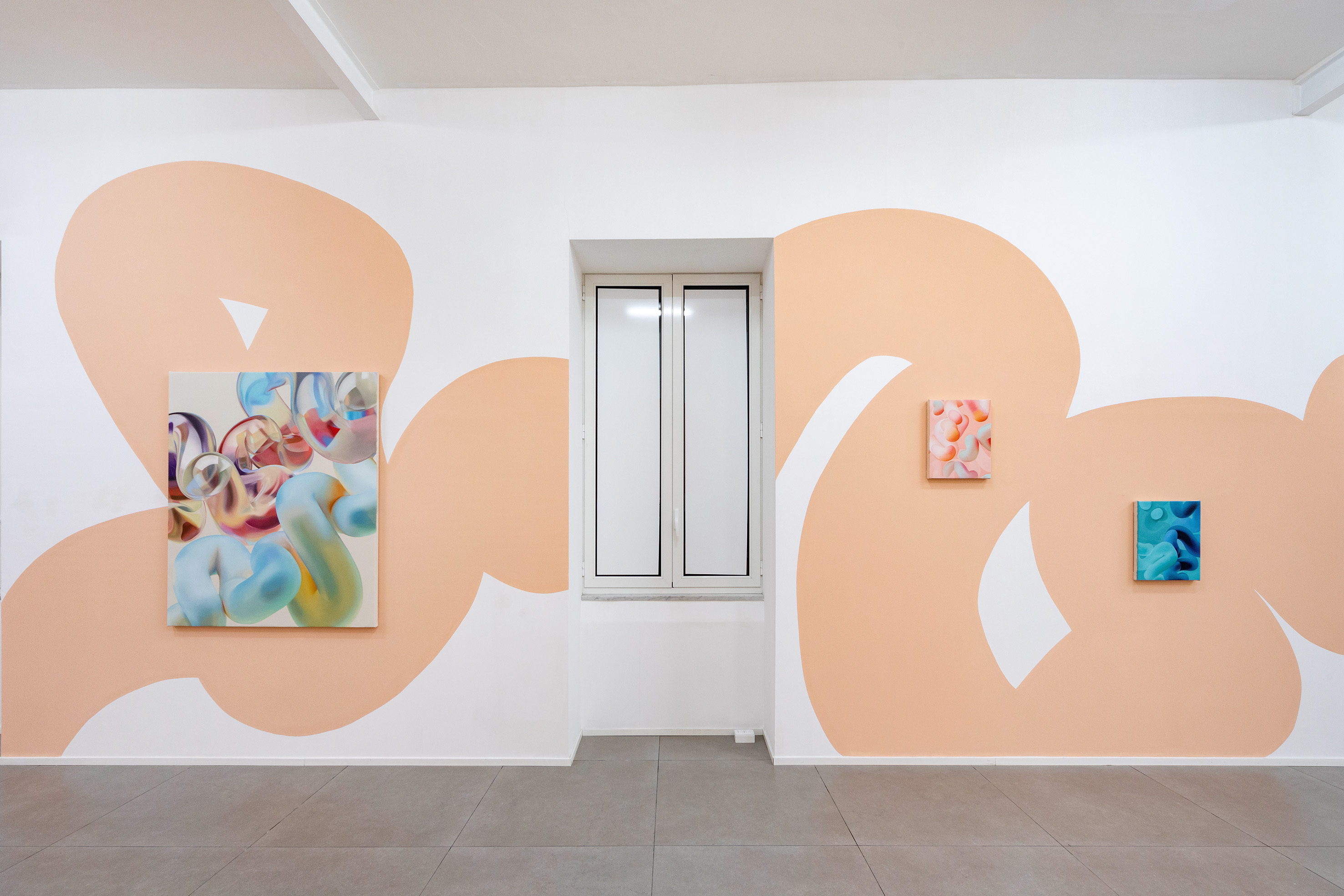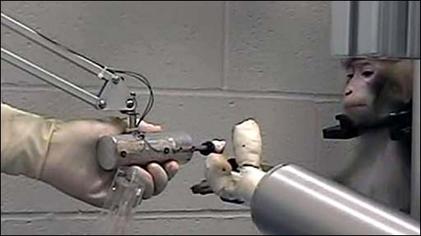Working Concerns for Digitally Engaged Painting
Vickie Vainionpaa
Last update: Oct 2 2021
1.
“Reality is just an idea one dreams up.” (1)
2.
A painting is part of a network. It reverberates with its own history. It is a passage from one site, which may be virtual or actual, to another. It is a vehicle for group artistic expression; As painters, we are in constant conversation with our intellectual collaborators across time and space. This network is an ever-expanding and evolving conversation which spans across multiple generations.
In order to successfully bridge past and present, we must also make room for new visions. Even still, our collective end goal remains the same. Frank Stella said that over the course of history, the problem of painting never changes: “You have a surface which you need to define”. (2)

3.
Computer generated imagery, when translated into traditional mediums, can amplify optical events and enable new perceptual states. A dialogue between artistic intuition and technical automation conflates both virtual and real into the seductive surface of painting. The painted surface benefits not only from (a) the physical contact of the artist’s hand and (b) the material primacy of oil on canvas, but also (c) the mysterious and utterly sensual paintability of CGI.
It seems, though, that the dynamics between the real and the virtual somehow leave me longing for more. There is always a gap — for now. It’s like trying to capture the experience of a beautiful, energy-rich sunset through the lens of a camera. You will never be able to keep the real thing, as hard as you try. I am endlessly interested in this gap between experience and perception, as I’m sure all painters are, and how it is, in fact, slowly narrowing.

Joseph Nechvatal coined the concept of the ‘viractual’ which strives to "create an interface between the biological and the virtual” (3). He suggests that the term may be helpful in defining our now third-fused inter-spatiality which is forged from the meeting of the virtual and the actual.
The space created by the viractual is liminal and transitory. Until we reach the apex of technological development (the 'Singularity'), we will be stuck in this in-betweenness with one foot in the digital world and one in the actual world.
4.
Zwischendingen (adj) - conflation for the German word for ‘between’ and ‘things’ = to be zwischendingen means that we are in between two things, two events that demarcate turning points. We are all currently zwischendingen. (4)
5.
Our experience in the world is so digitally mediated that it now seems second nature. A section from the book The Age of Earthquakes presents a common view that the more we interact with, depend on, and allow tech into our lives, the more we become, in a very real sense, artificial. (4) I would argue that the opposite is undeniably and equally true: The more that tech is interwoven into our lives, the more it becomes inextricably natural. In fact, I’m not a big fan of the word ‘un-natural’ or ‘artificial’.
The line between what is ‘natural’ and ‘unnatural’ is vague, complex, and relies entirely on the act of human intervention to be defined as such. If we take the traditional definition of natural, “existing in or caused by nature; not made or caused by humankind” (Oxford), we see where a philosophical dilemma may arise. If we choose to believe that the creations of human beings are inherently separate from nature, that everything natural has arisen without the intervention of intelligence in its production, then we are essentially arguing for a passive, unintelligent universe. In this view, ‘unnatural’ is synonymous with ‘human’.
Our experience in the world is so digitally mediated that it now seems second nature. A section from the book The Age of Earthquakes presents a common view that the more we interact with, depend on, and allow tech into our lives, the more we become, in a very real sense, artificial. (4) I would argue that the opposite is undeniably and equally true: The more that tech is interwoven into our lives, the more it becomes inextricably natural. In fact, I’m not a big fan of the word ‘un-natural’ or ‘artificial’.
The line between what is ‘natural’ and ‘unnatural’ is vague, complex, and relies entirely on the act of human intervention to be defined as such. If we take the traditional definition of natural, “existing in or caused by nature; not made or caused by humankind” (Oxford), we see where a philosophical dilemma may arise. If we choose to believe that the creations of human beings are inherently separate from nature, that everything natural has arisen without the intervention of intelligence in its production, then we are essentially arguing for a passive, unintelligent universe. In this view, ‘unnatural’ is synonymous with ‘human’.

But if we choose to see the universe (whether intelligent or not) as fundamentally natural, then everything in it must also be natural as it emerges, like branches on a tree, from purely natural phenomenon. This includes humans and all our creations. Artificiality or unnaturalness becomes a very fuzzy concept, one which is only useful for distancing ourselves from our moral and ethical fears. And we have, rightfully, many fears. Fears that push themselves to the front of our minds. I’m not saying we should do away with fear altogether, but I do think that putting too much priority on them distances us from true understanding, and limits our ability to participate fully in discussions of the future of our species. If we do not shift our thinking from techno-apocalyptic to techno-optimistic, how are we going to evolve?

Hieronymus Bosch x Google #deepdream via Kyle McDonald/Flickr
6.
Can the hyperreal “give us more reality than nature can”? (5) Digital technologies are the ultimate catalyst for the hyperreal. Fantasy and simulation can dominate here; The process of creating a parallel reality with variations on the gravitational and material properties as the one we inhabit is almost like playing God. It’s a painter’s paradise. This world, unlike ours, is untouched and wild, full of unrealized splendour.
The work of art reflects its own environment, but here, in an augmented, metaphysical state, one free from negative impact or careless disinterest. As part of both digital and physical networks, it connects us to a collective consciousness that implies a new and hopeful mythology. I sense this internal knowing, a bold idealism, that we must move forward optimistically in order to shape our future to match our aspirations.

This idealism is woven into the images I make. I feel it is my responsibility to depict a universe which stands for forward momentum instead of fearfully looking to the past. The philosopher Alan Watts says “technology is destructive only in the hands of people who do not realize that they are one and the same process as the universe” and that “the world is a marvellous system of wiggles”. (6)

7.
“One of our more radical thinkers has claimed that there is actually only one worm in the world, dreaming dreams to itself, traveling around making wormholes, traveling so fast that it meets itself at other location time/points, canceling itself out and coming to life again, immortal within the term of continual death and rebirth, flickering in and out of existence, and dreaming everything else, our civilization, our culture, our laws, our very existence. This Primordial Worm succeeds in deceiving himself into believing that there are many, and then, when that belief is his secure possession, he struggles to deceive himself that there is only one.”
Excerpt from Robert Sheckley’s Wormworld, 1991 (told from the point of view of a telepathic intelligent worm living inside a planet with no conception of an external reality)
“One of our more radical thinkers has claimed that there is actually only one worm in the world, dreaming dreams to itself, traveling around making wormholes, traveling so fast that it meets itself at other location time/points, canceling itself out and coming to life again, immortal within the term of continual death and rebirth, flickering in and out of existence, and dreaming everything else, our civilization, our culture, our laws, our very existence. This Primordial Worm succeeds in deceiving himself into believing that there are many, and then, when that belief is his secure possession, he struggles to deceive himself that there is only one.”
Excerpt from Robert Sheckley’s Wormworld, 1991 (told from the point of view of a telepathic intelligent worm living inside a planet with no conception of an external reality)
8.
I’m also thinking about physical bodies, flesh computers. How they curve, fold, and interact in ways reminiscent of a limb, intestine, or cellular organism. They are a sort of digital skin, floating in and out of macro and micro perspectives. I see the forms in my work as having life in themselves, coming from a different kind of nature — a digital wilderness, regulated by the forces of chance and uncertainty inherent to their digital environment.
McLuhan frames technological media as a sort of bodily extension — “detachable organs” (8) with which our senses are no longer limited to our physical bodies. The idea of the cyborg as an augmented post human body, one without gender, race, class etc. is an antidote to much current human conflict. Further, the cyborg is able to move freely between dimensions and maintain a multitude of perspectives, ebbing and flowing between worlds seamlessly. Like the Primordial Worm.

Monkey operating a robotic arm with brain–computer interfacing (Schwartz lab, University of Pittsburgh)
9.
Technology is not inert, digital forces are engaging with their own becoming. AI is advancing every day and, like good parents, we must teach our offspring love, compassion, and hope through every medium and every domain.
10.
And so, I paint.

Last update : 10/02/2021
Bibliography
1. Edmund Alleyn, From the show “In my studio, I am many”, MAC Montréal 2016
2. Frank Stella, The Retrospective Ed. Kunstmuseum Wolfsburg, 2012
3. Joseph Nechvatal, “Immersive Ideals/Critical Distances”, Ph.D. Thesis from CAiiA, University of Wales College, Newport, Wales, UK, 1999. Interview with Joseph Nechvatal
4. Douglas Coupland , Hans Ulrich Obrist and Shumon Basar, “The Age of Earthquakes A Guide to the Extreme Present”, 2015
5. Eco, Umberto. Travels in Hyperreality. Sand Diego and New York: Harcourt Brace and Company, 1983.
6. Alan Watts, A Conversation with Myself, 1971 Available on Youtube
7. Robert Sheckley, “Wormworld” in Divine Intervention, 1991 Available on Google Books
8. McLuhan, Marshall. Understanding Media: the extensions of man. The MIT Press, Cambridge, 1994.